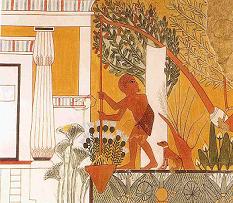 »
Home & Garden Directory
»
Article Directory
»
Home & Garden Articles
»
»
Home & Garden Directory
»
Article Directory
»
Home & Garden Articles
»
History Of The Early Gardens
 In the beginning there was a garden with natural water fountains. Creation's garden. And life was good. All plants were natives. Food was pure and abundant. Predators and prey were in balance (which is not to say they were equal).
In the beginning there was a garden with natural water fountains. Creation's garden. And life was good. All plants were natives. Food was pure and abundant. Predators and prey were in balance (which is not to say they were equal).
Then people got involved and introduced concrete fountains and many other things. They brought with them their urge for order and control, and a robust curiosity fed by experimentation. Soon, the earth was plowed into furrows and crops planted in rows. The best specimens were selected for breeding.
Yet even after farmers began growing food for whole communities, and pharmacists took responsibility for mass-producing medicine, people continued to tend gardens. For sustenance, yes, but also to create beauty, retain a connection to nature, and enjoy the simple pleasure of digging in dirt. Cast stone fountains were a way to carry water to the gardens. For a clearer picture of what a cast stone fountain looks like visit http://www.garden-fountains.com/Detail.bok?no=61.
For nearly... well...forever, gardeners and farmers grew plants using common sense, careful observation, and the resources nature provided. Today, we call that approach "organic." But that term became necessary only to distinguish those time-tested tactics from the shortsighted chemical practices foisted on the public in the name of progress within the last century. The garden was, and always will be, our connection to the earth. The garden may be the true water fountain of youth.
7,000 B.C. Barley, millet, and lentils are cultivated in Thessaly, one of the Greek isles.
5,000 B.C. The staples of Native American cuisine, corn (maize) and common beans, are cultivated in the Western Hemisphere.
4,0000 B.C. Hello, variety: The people of the Indus Valley (what is now Pakistan and Afghanistan) are raising wheat, barley, peas, sesame seeds, mangoes, and dates on irrigated fields, as well as bananas, citrus, and grapes for wine in smaller plots.
3,000 B.C. Potatoes are cultivated and harvested in the Andes Mountains.
2,700 B.C. The Egyptians already know and grow 500 medicinal plants.
2,700 B.C. Olive trees are raised in Crete.
2,000 B. C. Watermelon is cultivated in Africa; figs are cultivated in Arabia; tea and bananas, in India; and apples, in the Indus Valley.
1,900 B.C. The Egyptian pharaoh Ramses III commissions more than 500 public gardens.
600 B.C. The Hanging Gardens of Babylon, one of the Seven Wonders of the Ancient World, are built by King Nebuchadnezzar II (with help, no doubt, from a few thousand slaves). The gardens are laid out on a brick terrace about 400 feet square and 75 feet above the ground. Irrigation screws are designed to lift water from the Euphrates River to the gardens.
301 B.C. In the History of Plants and Theoretical Botany, Theophrastus (considered the Father of Botany) describes plant diseases, such as rusts and mildews, and explains how to hand-pollinate fig trees to maximize productivity.
149 B.C. Cato the Elder, in De Agriculture, urges farmers to plant grapes and olives (because they draw moisture and nutrients from the subsoil) instead of planting drought-susceptible grain.
900 A.D. Tofu becomes a dietary staple in China.
1305 Opus Ruralium Commodorum, by Bolognese agriculturist Petrus de Crescentiis, is the first book on agriculture to appear in Europe since the second century.
1354 The Alhambra, built by the Moors in Spain, is completed. The Islamic-style garden features enclosed courts surrounded by arcades, planted with trees and shrubs and enhanced with tile, fountains, and pools.
1510 Sunflowers from the Americas are introduced to Europe by the Spanish. In many countries they become a major oilseed crop. In others, they are bird food.
1528 Sweet potatoes, and haricot, cocoa, and vanilla beans, are introduced to Spain by Hernando Cortes, who presents some of the beans to Pope Clement VII. Until then, fava beans have been the only beans known to Europeans.
1540 A potato from South America reaches Pope Paul III via Spain. The pope gives the tuber to a Frenchman, who introduces it into France as an ornamental plant. Stay tuned for French fries.
Gardening continued to evolve with the addition of water wall fountains, new vegetables, fruits, flowers and bulbs from various parts of the world. For a distinctive water wall fountain idea visit http://www.garden-fountains.com/Detail.bok?no=66. Machinery and chemicals also evolved as the demand to feed the world increased. Today, we face the overuse of synthetic nitrogen by farmers that causes soil to age the equivalent of 5,000 years. The good news is that composting can replenish depleted soils in just one season.
About The Author
Elizabeth Jean is an outdoor gardening writer and frequent contributor to http://Garden-Fountains.com, a popular Internet destination for water fountains and garden statuary.
 »
Home & Garden Directory
»
Article Directory
»
Home & Garden Articles
»
Home & Garden Directory
»
Article Directory
»
Home & Garden Articles
» History Of The Early Gardens [Top]



 Articles
Articles